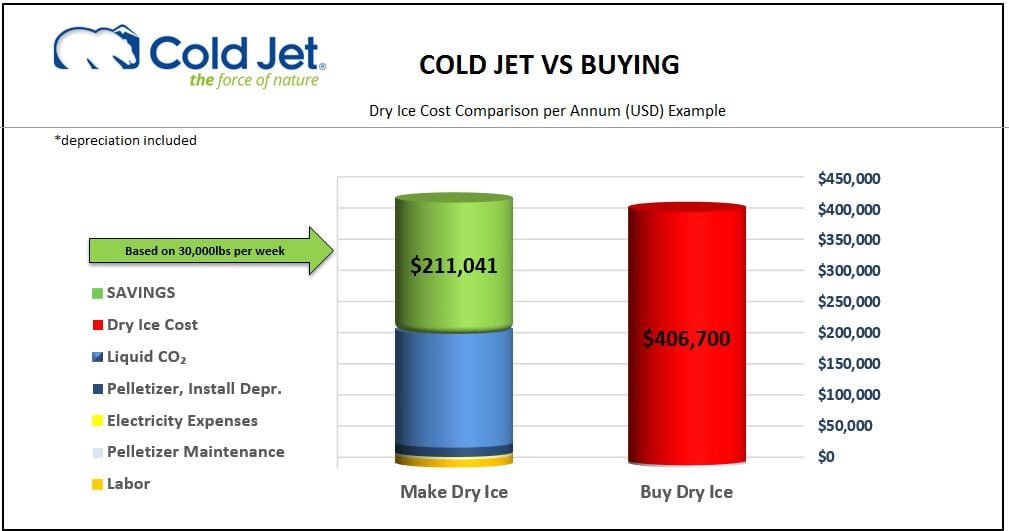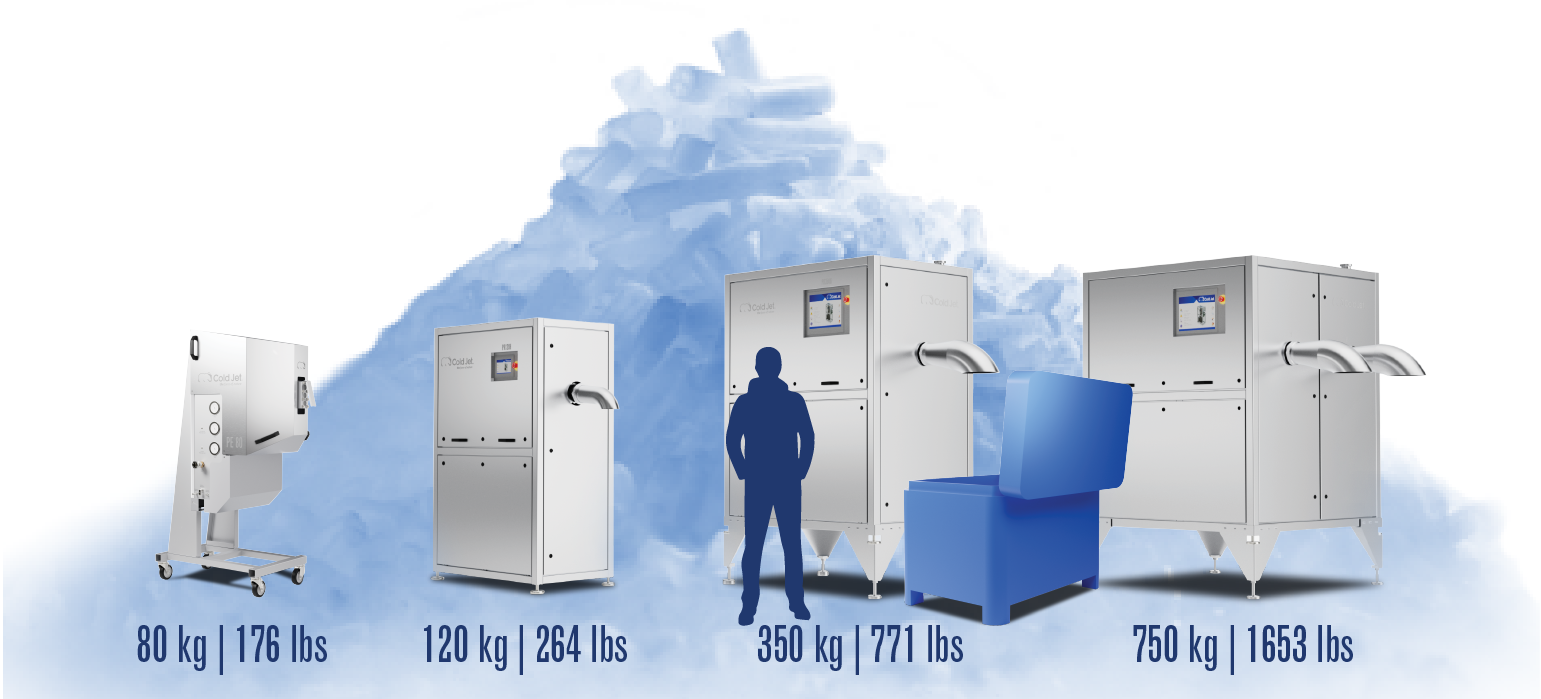
If you're wondering "Should I make my own dry ice?", you've come to the right place.
We get this question a lot. In the right situation, making your own dry ice can save you a lot of time and money while eliminating headaches. Producing your own dry ice can:
1) Give you greater control over your production, processing, and cold chain management systems.
2) Both reduce waste and cut operational costs, which boosts efficiency.
How do you know if it makes sense to implement dry ice production at your plant? That can be determined by considering a few simple questions...
Key Questions for Evaluating Your Dry Ice Needs
-
How much dry ice do you use on a daily/weekly basis? What are you paying per pound/kilogram? Dry ice manufacturing follows the typical production economies of scale. The more you need, the cheaper it is to produce.
- What is your current delivery cost and how many deliveries of dry ice do you receive each week? The more deliveries you receive, the higher you're paying in delivery fees. You also run a greater risk of supply disruption.
- Is the supply of dry ice a part of a critical path in your operation? Making dry ice yourself allows you to be less dependent on a vendor's production and delivery schedule because you can make it on demand—when you need it, where you need it, and the amount you need. This is especially vital for time-sensitive uses like airline catering, food processing, food transportation, and Medical and Pharmaceutical Shipment Cooling.
Check out this blog: Maximize Shelf Life, Minimize Spoilage: Using Dry Ice In Food Storage
- How crucial is the quality of the dry ice to your operation? Fresher and minimally handled/processed dry ice pellets and dry ice slices are less exposed to moisture and therefore are more consistent, higher density, and last longer.
.jpg?width=2560&name=blocks%20of%20dry%20ice%20(2).jpg)
5. Do you want more control over product quality? Making your own dry ice can simplify your supply chain, which gives you more control, easier traceability, and lowers the risk of cross-contamination.
6. Do you need automated dosing of dry ice as part of your production/delivery process? Turn-key automation is available from dry ice manufacturing through measured dosing and packaging.
7. Does storing your dry ice take up a lot of space? If you make it yourself, you can make it on demand and minimize the floor space needed.
8. Do you waste a lot of dry ice each week? Making it on demand, only in the amount needed, can drastically reduce waste from sublimation and eliminate the need for over-ordering.
9. Do you currently use a lot of CO2 snow? Making and using dry ice instead of CO2 snow can greatly reduce the amount of CO2 consumed. Typically, machines that convert CO2 liquid to solid dry ice pellets or dry ice slices are much more efficient than CO2 snow horns. Also, dry ice typically cools better and lasts longer than snow, making it a more sustainable cooling choice.

10. Do you already have a CO2 tank* and three-phase power? Having some of the infrastructure needed for dry ice production already in place will lower the cost of implementing a dry ice production system.
Infrastructure for Establishing Your Own Dry Ice Production
To establish your own dry ice production, you’ll need variations on the following infrastructure needed for dry ice production, depending on the desired dry ice volumes:
1. Access to liquid CO2 in your region.
2. An on-site liquid CO2
3. A reinforced concrete foundation for stability.
4. Insulated pipe work to connect your exterior liquid CO2 reservoir to the dry ice production system.
5. A Cold Jet dry ice production system, protected from moisture and the elements, with plenty of room for production.
6. A three-phase electric power source for the Cold Jet dry ice manufacturing
7. A compressed air line.
8. Safety measures, including artificial ventilation to maintain airflow within the manufacturing facility.
9. A CO2 PPM monitor.
10. Insulated containers to store dry ice, minimizing sublimation.
*If you do not have a liquid CO2 supply already in place, Cold Jet can perform a site visit to help determine what you would need to do and what your investment and payback would be. Cold Jet can then arrange for the installation and leasing, if required, to be completed through our trusted affiliates.

Your Partner for Dry Ice Production Solutions
Cold Jet is the global leader in dry ice production technology with the most customer installations worldwide. We provide superior solutions that save companies time, money, and resources. We offer the most advanced and efficient dry ice manufacturing and customized engineered systems with superior end product quality, coupled with 24 hour, 7 day a week production capability and customer support.
Cold Jet’s dry ice pelletizers, reformers, slice lines, and mobile dry ice manufacturing hubs have been engineered to offer the greatest level of reliability in the most demanding environments and the highest density dry ice.
The Widest Selection of Dry Ice Production Machines

Cold Jet’s dry ice manufacturing technology offers the widest selection of dry ice production machines on the market, ranging from small-scale units with a capacity of 265 lbs (120 kg) per hour—perfect for a low volume dry ice production line—to a very high volume dry ice production line of 2400 lbs (1100 kg) per hour.
We carefully evaluate customer’s conditions regarding dry ice production and advise the optimum solution based on their needs and expectations. Cold Jet manufacturing systems are now the choice of all the major dry ice producers in the Americas, Europe, and Asia.
With Cold Jet you can expect:
- The best consultancy about dry ice technology
- Various delivery options, including turn-key
- Highest quality extruded dry ice available
- Fully automated, one-button automation
- Lowest liquid/solid CO2 conversion rates available
- Advanced remote service and diagnostics monitoring
- Best output to footprint ratio
- Several patented dry ice technologies
If you're considering the shift to in-house dry ice production, what's the next step you plan to take to evaluate your current costs and volume?
Are you ready to explore your dry ice production solutions options? Let's talk.
.png) English
English